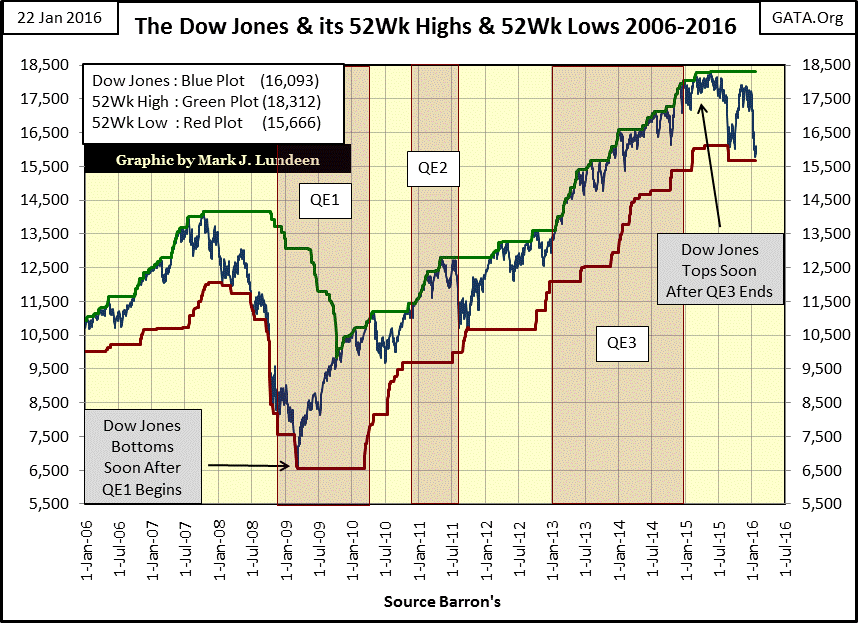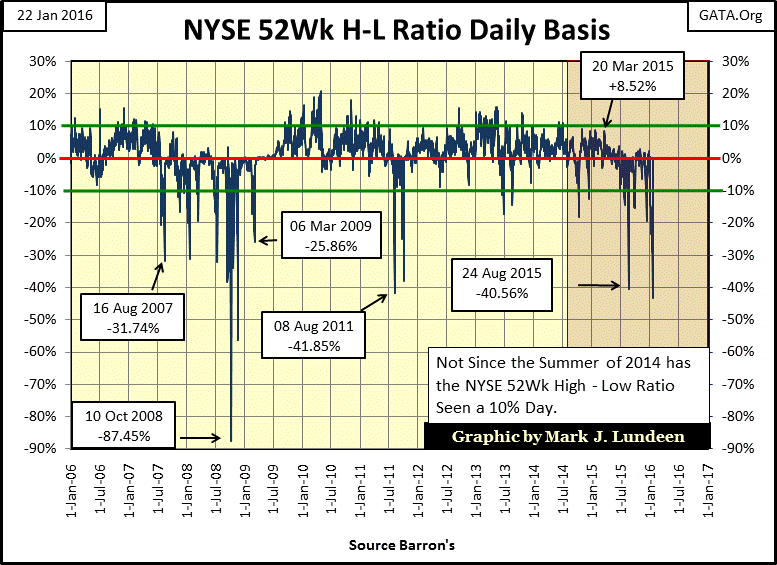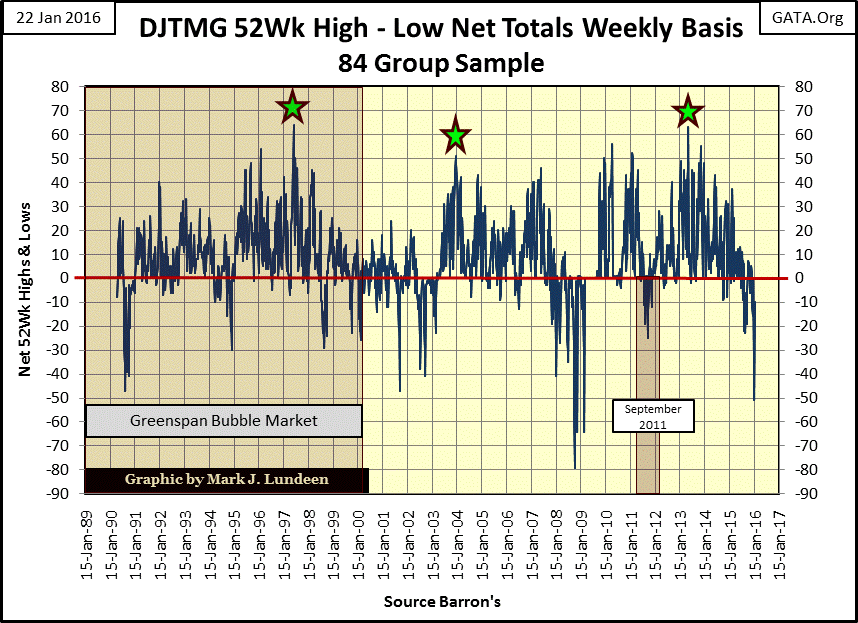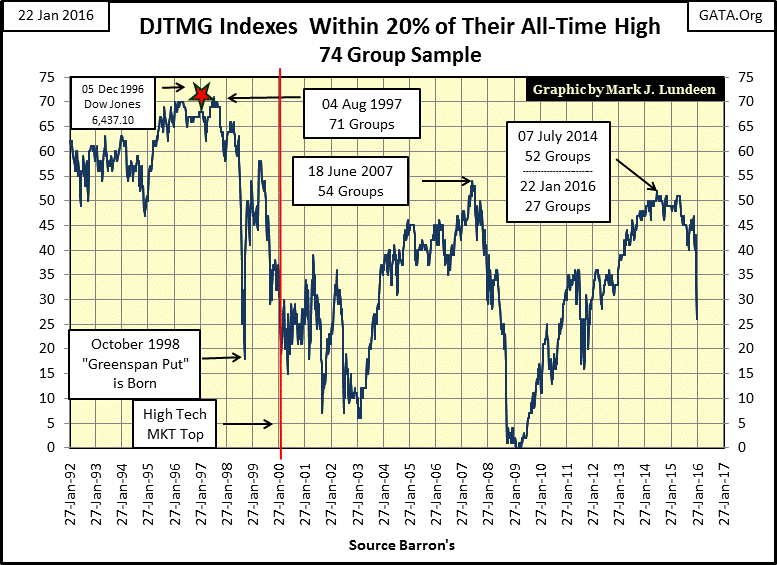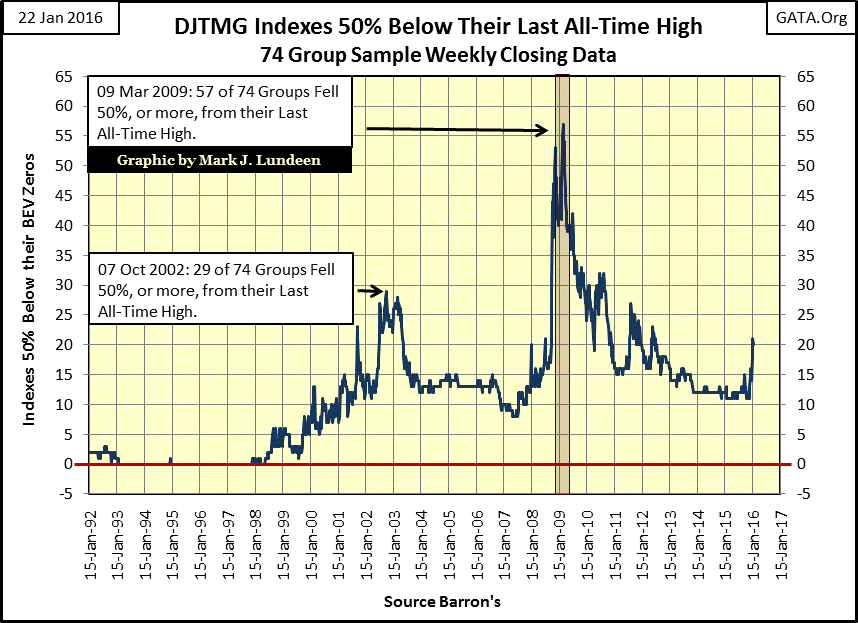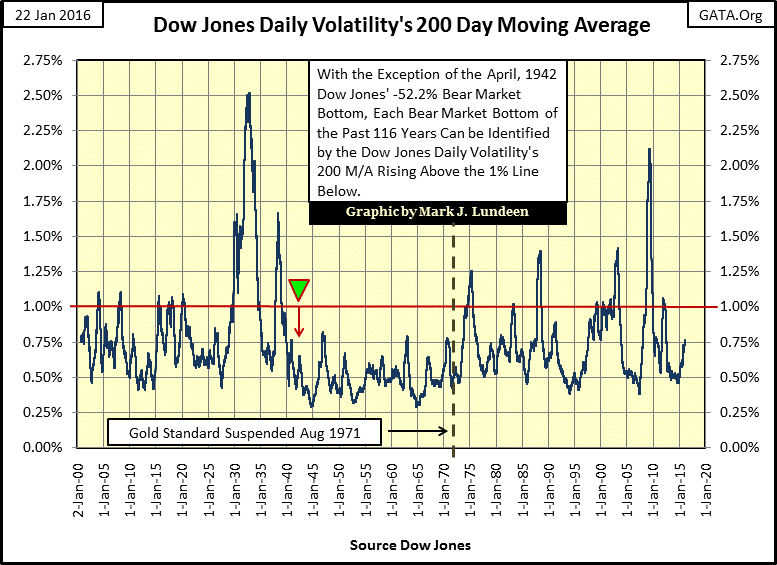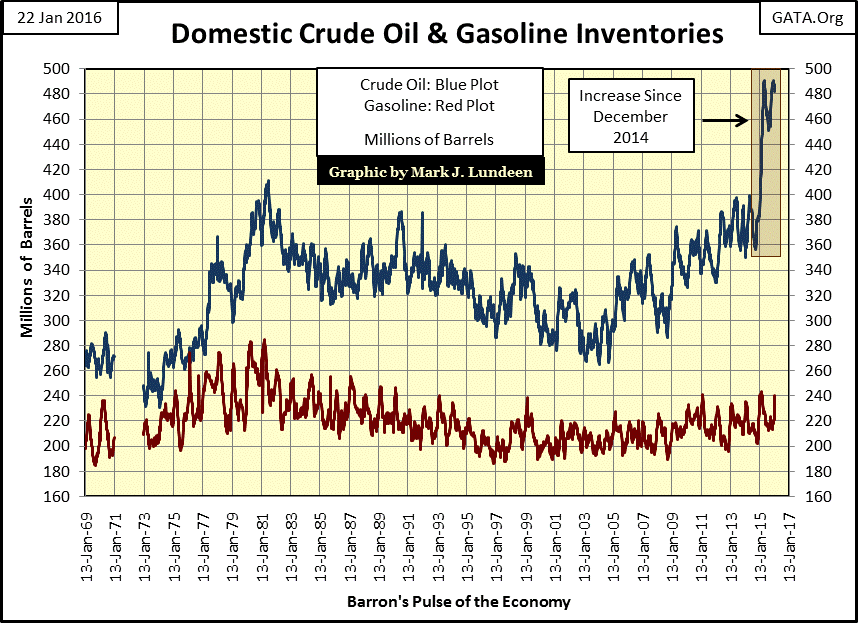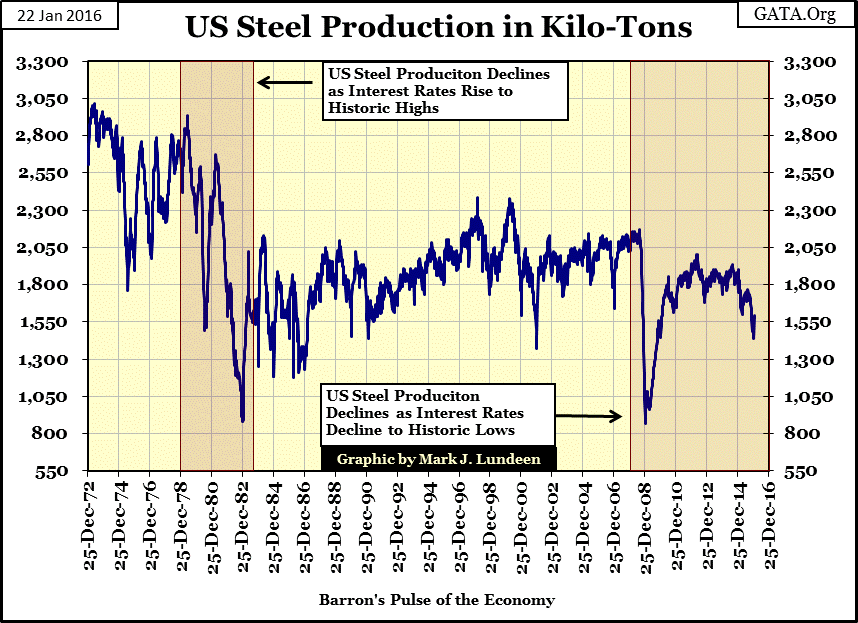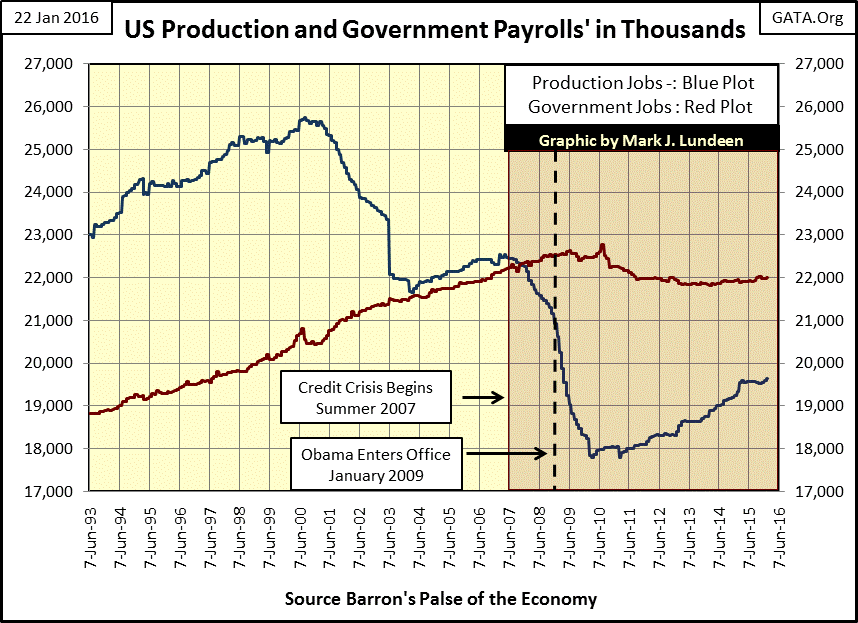The Bear Market Continues
The Dow Jones Index managed to eke out an advance last week, but only by 105 points from the previous Friday’s close. The Dow Jones has been under tremendous selling pressure these past three weeks; the first three weeks of 2016. If the current decline is merely a correction within a bull market I’d have thought we’d see more of a bounce than this on its first up week in 2016.
Wednesday morning saw the stock market in an actual panic. By noon the Dow Jones had dropped to a new 52-week low. Had the Dow closed at that level, it would have been a day of extreme volatility with daily decline of 3.5%. At noon Wednesday there were 30 declining shares for every one advancing at the NYSE. So two new extreme market events could have, and maybe should have taken place on Wednesday…and reported on Mr Bear’s report card below. However the PPT (Plunge Protection Team) came to the rescue and robbed Mr Bear of his trophies. Wednesday was still a brutal day of trading ending with 1,390 new NYSE 52Wk Lows, and 2,287 shares declining of the 3,225 trading. By the end of the week, even with massive PPT intervention, Mr Bear still racked up one more extreme market event on Friday, a day of extreme market breadth with a positive A-D Ratio of 77.40%. Below we see the specifics for Friday’s extreme day of market breadth.
2,841 Advances – 351 Declines / 3,217 NYSE Listings Trading on Friday
This is the third straight week in which we’ve seen an extreme market event – something known to occur week after week in big bear markets. Even a positive extreme day such as this adds to market volatility and should be taken as a warning sign, not a reason to believe a bottom is at hand.
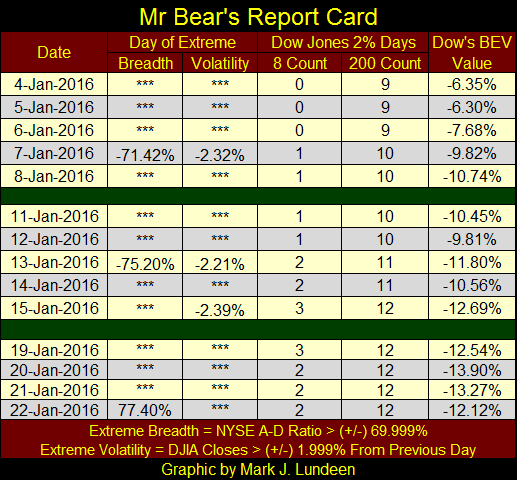
Here’s the chart for the NYSE 52Wk H-L Ratio. The PPT may have salvaged the market on Wednesday, but by Wednesday’s close the 52Wk H-L Ratio still took out the lows of last August.
Looking at the Dow Jones Total Market’s (DJTMG) 52Wk H-L data, we see it declined to -51. (I have to note that that occurred last week, this week it closed at -10.) Since 1990 this ratio has exceeded -50 only twice; last week and during the credit crisis.
Last week the DJTMG’s “Top 20” collapsed to 26, or only 26 of 74 total groups within 20% of their last all-time high. Need I say that this is not a promising trend?
However as bad as the decline in the DJTMG’s “Top 20” is, the growth in its “Bottom 50” (the number of groups having declined 50% or MORE from their last all-time high) is worse. From the last week of November to the end of this week the number of groups in the Bottom 50 has jumped from 11 to 21 in the chart below with 9 of these groups down by 75% or more. For now the big decliners are for the most part in mining and energy production. However as the bear market deepens there will be more groups in other areas of the economy that will also lose 50% of their market valuation, driving the Bottom 50 to much higher levels.
Daily market volatility continues to increase, as it has done continually for the past year. The chart below tells the story of bear markets and the volatility they have brought to the Dow Jones since 1900. Every bear market, except the 1942 bear market bottom, occurred on rising daily volatility in the Dow Jones – which is why I closely follow Dow Jones moves more than (+/-) 2% from a previous day’s closing price; aka days of extreme market volatility or 2% days.
I’m convinced we’re in the early phase of a massive bear market. If I’m right, we’ll continue seeing the plot below rise up to, and then exceed its 1% line as the Dow Jones declines to ever lower levels. There’s no way to say how far the Dow Jones could fall from this data. But knowing how poorly the “policy makers” have managed the economy and financial markets over the past three decades, my expectations are for a market decline of similar proportions to that of the Great Depression of the 1930s. At the bottom of the 1929-32 bear market the 200-day M/A for the Dow’s daily volatility increased to more than 2.50%. Hopefully it won’t get that bad at the bottom of this bear market, but I could be wrong.
The one thing I feel confident about when looking at this data is that this is not a time to be a buyer of what Wall Street is selling to the public. This is a time to get out, take your money with you and not come back to the market for a few years. Buy some gold and silver bullion. As the market becomes painfully aware of counterparty failure becoming a factor you’ll be glad you did.
What a horrible month January 2016 has been. What should be going up is going down, and what should be going down is going up and what about all those extreme days Mr Bear is so fond of? January still has five trading days before it passes into history and so far we’ve seen six extreme market events! We are way past examining “bear tracks.” Seeing six extreme market events in only three weeks is watching the market step on bear scat. After all this carnage we really are due for a relief rally, something more than what we saw this week with the Dow Jones up just 105 points since last Friday – but I’m not planning on it.
“Market experts” and economists frequently remind us that our economy is growing, but strangely they never show us the charts that brought them to that conclusion. As Barron’s has published data on the economy for many decades, I thought this week my readers would be interested in a few charts from their data set; first the domestic inventories for crude oil and gasoline.
I remember when back in the 1980s & 90s the only outlook for North American crude-oil production was that of “peak oil” seen below in 1981 (Blue Plot). According to advocates of peak oil, domestic US oil production was all downhill from then on. For twenty-four years the decline in crude production predicted by these “market experts” was correct, but then something changed in 2006 – rising crude oil prices made fracking for shale oil profitable. I’m not going to argue that we don’t live in a finite world, because I know we do. But time after time “market experts” have demonstrated their limited understanding of the potential of our finite world.
In a world already drowning in crude oil Iran will soon be coming on line with even more new supply. The current market outlook for crude is one of concern where to store all this excess oil. One would think the logical thing to do would be cut back on production, or even stop shipping oil to market. Decades ago when the industry was dominated by companies like Exxon and Royal Dutch Shell, companies who were for the most part debt free that is exactly what would have happened.
But today the big petroleum companies are owned by nations where the oil deposits are located, such as the Persian Gulf or Venezuela. These companies use profits from crude oil production to provide social services for a population that is typically at odds with the political establishment. Reducing supply risks political instability for governments managing the oil production. The shale oil companies of North America are newly created companies that required massive amounts of debt, and much higher crude oil prices to finance their continued existence. Currently, these companies have one thing in common; the lower the price of oil falls, the more they plan to increase production as political considerations or debt service leaves them with no other option.
“Reuters noted that Saudi Arabia has few options but to stick to its strategy of defending market share, no matter how low prices fall. It said recent comments from the chairman of Saudi Aramco reinforce the stance after he argued the kingdom could withstand low crude prices for a long time and it would not act alone to support the market. The massive reserves it has accumulated over the past decade will give the government plenty of time to cushion the blow of cheap oil.”
- Bill Murphy’s Midas Comments for January 22
The decline in the price of oil has gotten to the point where bank loans, bond and derivatives used to finance the current excess capacity are at risk of an actual default. Zero Hedge had an exclusive that the Dallas Federal Reserve bank instructed its member banks not force bankruptcy on energy companies unable to service their debts to the banks (click to read).
“Which brings us to the focus of this post: earlier this week, before the start of bank earnings season, before BOK's startling announcement, we reported we had heard of a rumor that Dallas Fed members had met with banks in Houston and explicitly "told them not to force energy bankruptcies" and to demand asset sales instead.”
This may sound reasonable, but refusing to allow bankruptcy for companies that couldn’t make a profit was one of the “policies” that drove the old Soviet Union into the “dustbin of history.” The real concern for the Dallas Fed is that if their banks force these companies into bankruptcy, the banks themselves may also go bankrupt. That is something “policy” will not currently allow, so corporate accounting has taken another leap into fantasy as reality has become ever more toxic in the world we live in. But reality can only be denied for so long.
David Stockman reports that $117 billion in investment grade energy bonds will soon be downgraded to junk status and that is just the start of many problems pending in the bond market.
Here’s a chart plotting US domestic steel production. If the economy actually has turned around domestic steel producers certainly haven’t benefitted.
Below are plots showing private sector (Blue Plot) and government employment (Red Plot) since 1993. Every time Wall Street has had a bear market over the past three decades, (as we saw in 2000 with the tech wreck and in 2007 with the credit crisis) - the private sector has lost jobs – and they never come back.
It’s no fun being a big bear on the stock and bond markets. The only thing worse might be having been a big bull in gold and silver over the past few years. But I still believe Mr Bear has returned to haul out the garbage in everyone’s investment portfolio. And in January 2016 there is a lot of garbage to haul out! That also goes for the “assets” held by the Federal Reserve and other central banks. For years these central banks have “supported market valuations” by buying what no one else wanted at inflated prices no one else was willing to pay, funding this insanity with monetary inflation. There will be consequences to what the “policy makers” have done. Having a good position in gold and silver bullion just seems the prudent thing to do in today’s world.
Mark J. Lundeen






